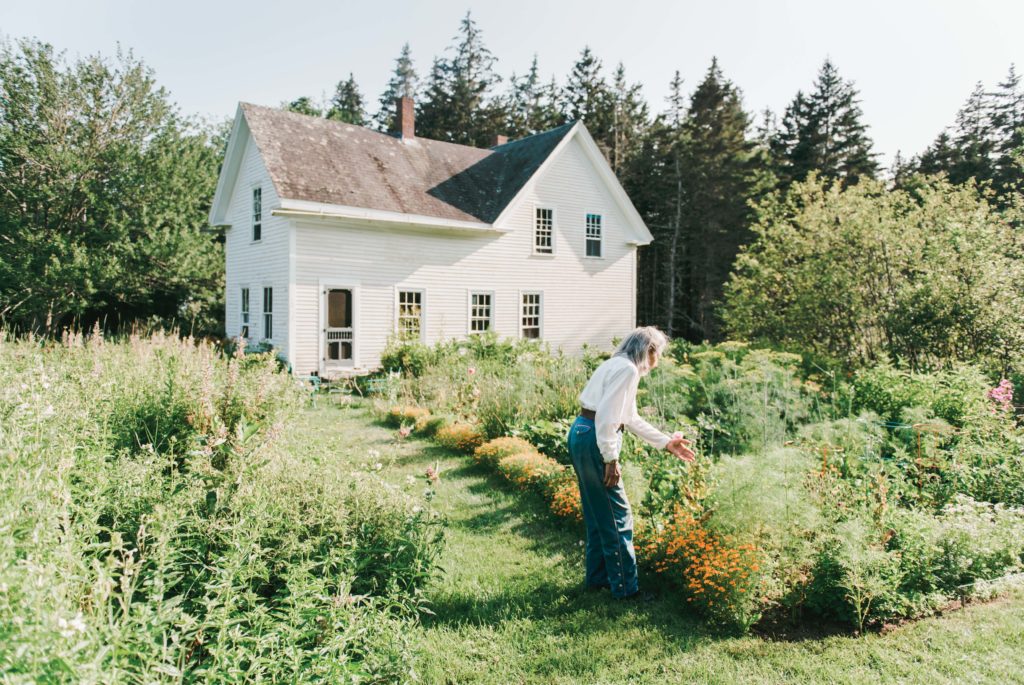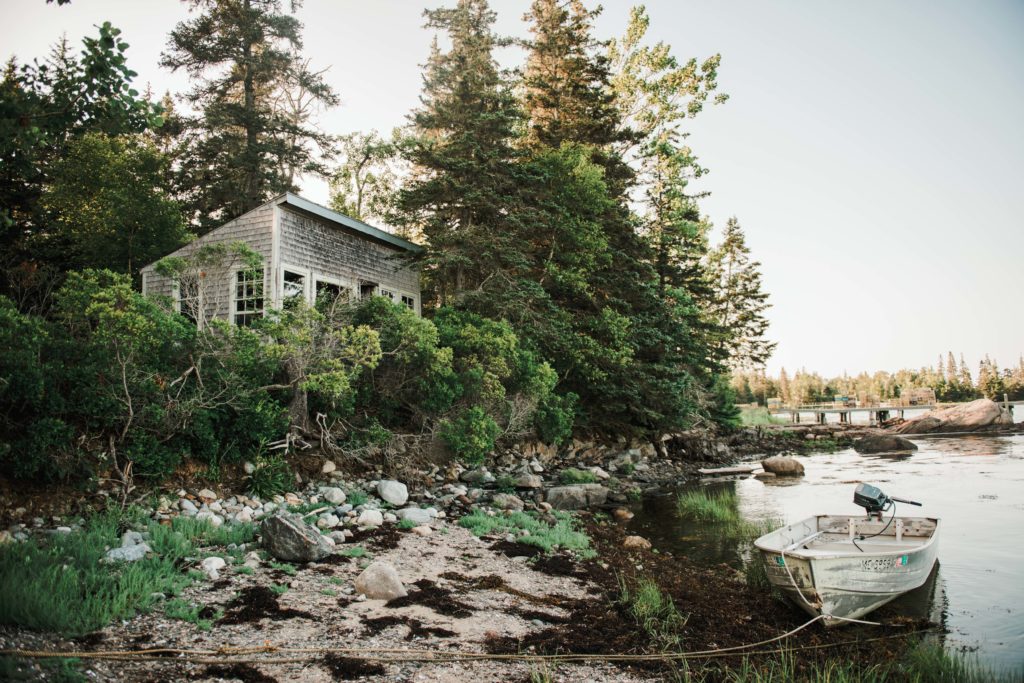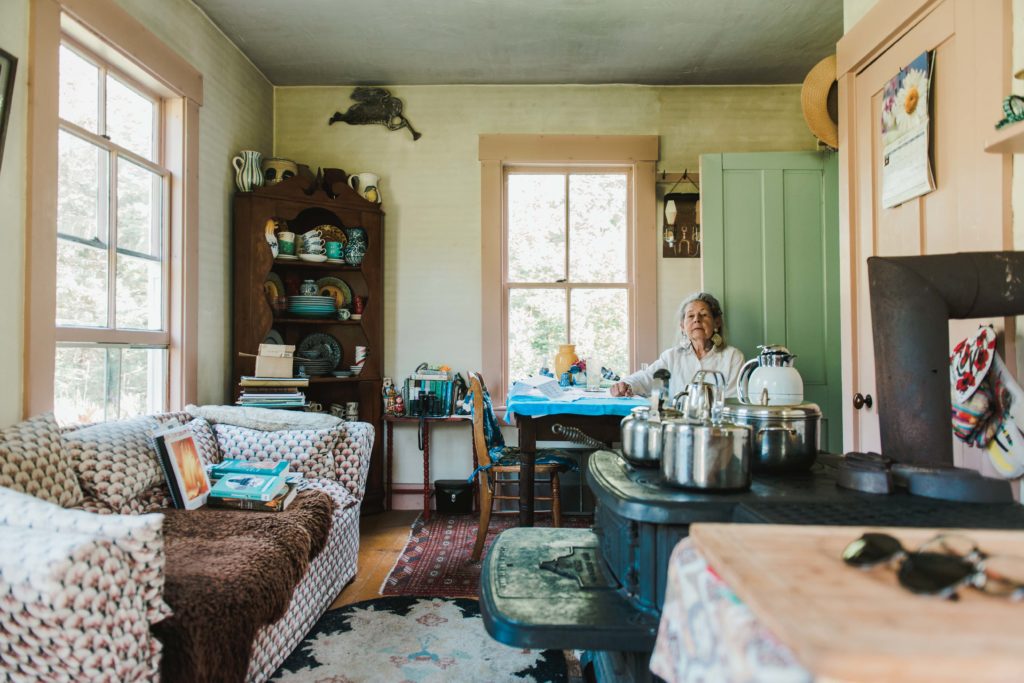A Life of Her Own
Lifelong artist Barbara Beebe embraces inspiration and solitude in an off-the-grid home on an island in Friendship.

A Life of Her Own
Lifelong artist Barbara Beebe embraces inspiration and solitude off the coast of Friendship.
Issue: October 2019
By: Pippa Biddle
Photography by: Christina Wnek
If you’ve never heard porcupines battle over milkweed, listen closely when the sun has set and the world is quiet. That’s when they lumber into a field of tightly packed stalks and grunt and squeal and trample between bites.
Barbara Beebe warns guests not to use the outhouse at night because the path curves past the local porcupines’ favorite milkweed spot—the meadowed clearing that extends downhill from her front door—and they aren’t fans of intruders during their nightly feasts. If nighttime bathroom breaks are necessary, there are chamber pots you can pour out onto the grass in the morning and rinse with water pulled from the well. If you’re a coffee or tea drinker, you might consider grabbing a few more pieces of wood and a handful of kindling from the pile while you are out. She will need them to start the stove.

Beebe, now in her 80s, grew up on a farm in North Dakota with many siblings and lots of space. Their home never had the things her farmhouse lacks today: running water, electricity, a gas line, refrigeration. The newspaper isn’t delivered to Friendship Long Island, a three-mile-long and one-mile-wide island ten minutes by motorboat from the Friendship dock, so news, like life, moves more slowly here.
But when Beebe was young, things were moving rapidly. Her early years coincided with the Great Depression, and her rural community was a cog in the American agricultural machine trying to keep a floundering nation fed.
While her father and uncles worked in the heart of the Red River Valley, she attended Eldorado #5, a one-room schoolhouse. Understanding her childhood illuminates her art, which freezes the decay of time in the bright colors and bold lines of her preferred medium: gouache.

In December 1947, during Beebe’s senior year at Hillsboro High School, her father, Norman Engel, was loading potatoes into a train car when fumes from a heater needed to keep potatoes from freezing in the frigid North Dakota winters knocked him unconscious. He fell into the car and died from asphyxiation. He’d vowed that his children would go to college. Six of the seven would fulfill that promise. Barbara graduated from the University of Minnesota in 1952 with a degree in art design.
This was all well before my and Beebe’s lives would cross, but by the late 1970s that ball was rolling. By then, Barbara Engel had headed east, gotten married, changed her last name to Beebe, and was living on the campus of the Loomis Chaffee School in Windsor, Connecticut. When my mom visited my uncles at the school, they would meet at the Beebes’ house. Beebe’s father-in-law delivered my grandfather into the world, so it was a little like visiting family or, at least, people who knew too much about you to not keep them close.

Beebe’s signature look is a reminder of her North Dakota roots; candles provide light for reading after dark. 
Beebe carries firewood from the garden house to her kitchen. 
Prom Dresses on the Prairie (oil on canvas, 2003) watches over Beebe’s home studio.
My mom built a friendship with Beebe, who is 30 years older, that transcended generations, but they lost touch as each went in search of herself. For my mom, that meant college, my dad, a career, and kids, starting with me. For Beebe: a divorce, designing and creating high-end jewelry sold in galleries nationwide and thrice featured in Vogue, Friendship Long Island, and, after a fall on ice, drawing and painting.
When I was one or two, my mom took me from Brooklyn, New York, to Friendship Long Island. Beebe had just written a play and she put on a puppet show for us. Perhaps it was only the blood of a scraped knee or the top layer of a skinned palm, but I think a piece of me stayed there. Beebe has felt a connection with the island deep in her bones since before purchasing her Civil War-era home with her daughter, Susan Beebe, also a Maine-based artist, in 1985. It had sat vacant for 20 years before they decided it would be their perfect three-season homestead—with a handful of winters thrown in for good measure.

Lobster scientist Diane Cowan, who was famously iced in on Friendship Long Island for 34 days in 2015, can attest to how inhospitable winter is on the island. Cowan has had one of Beebe’s paintings hanging in her home there for nearly 20 years. It is of Beebe’s house against the night sky, with the Big Dipper just grazing her roof. To execute it, Beebe went out late at night and sketched the contours of the stars that seem to shine brighter because they know few people are looking. She labeled where was dark and where was darker with pencil, creating a paint-by-number for herself to follow in daylight, when she filled in the image with grays and blacks and gray-black blues, and a pop of red upholstery peeking through the side screen door. The piece is stark, but stunning, and reminiscent of the harsh lines with soft edges that framed her childhood. She doesn’t mention whether she had to face off with porcupines in the process, but the company might have been welcome.
“Perhaps it was only the blood of a scraped knee or the top layer of a skinned palm, but I think a piece of me stayed there.”
Throughout history, there have been female mystics renowned for their self-imposed isolation. Julian of Norwich is my favorite. She lived in the fourteenth and early fifteenth centuries, and cultivated a life based around contemplative solitude; it drew people seeking answers, questions, or simply to share the air she breathed.
People who willingly isolate themselves are nearly universally fascinating, especially to those of us who surround ourselves in movement as if with a safety net. “They must know something,” we whisper to each other when we think they can’t hear us. We try to discover their secrets by getting close to them, asking them for guidance, touching their hand, or sitting next to them on a pebble beach watching the tide come back in. When I suggest to Beebe that she may have cultivated a life of aloneness that draws people to her presence, she doesn’t reject the idea. At her studio, which is perched on the edge of the island, she creates beauty and emotion out of solitude. And out of this space comes nearly boundless creativity.

“One thing I always have in my mind, always, is that I want to play,” Beebe says, nearly giggling. “Sunday is my day to play, and I can do anything I want to. I can be silly. I can make toys. If you allow yourself to play, it’s freeing.” This explains the puppet theater that monopolizes a corner in her living room, 25 years after my first visit. Her house is packed with art, including neatly framed paintings and drawings that have been shown in galleries throughout Maine since 1998. Many are of the architecture of life in disrepair: abandoned North Dakota barns, abandoned churches, the abandoned granite quarry on the other side of the island, and a broken-down Studebaker she found in the forest of the island, which now has no roads or cars. She’s not sure why she’s drawn to these subjects. “It appeals to me,” she says; “that’s all I can say.”

Other paintings are of people. Prom Dresses on the Prairie (oil on canvas, 2003) is based on a photograph. In the painting, she is a junior in high school. Her sister, Devonne, is a senior. Beebe is on the left in a dark rust top and dusty blue skirt that flip the colors of the flat expanse behind her: dry dusty land below, muted sky above. Near the painting is a mockup of Chickadee Afloat, a children’s book written and illustrated by Beebe that features a wandering boat named Chickadee. It is reminiscent of the vibrant children’s books of the 1940s, classics like Blueberries for Sal by Maine’s own Robert McCloskey. Beebe hopes to publish Chickadee Afloat. For now, guests can flip through the pages of the mockup and feel her paint on their fingers.
After looking through what feels like hundreds of pieces created over decades, I wonder what drives her forward creatively. It must go beyond a passion for play, especially as the passage of time has required the work to become more purposeful. Painting has always been a process, but what was once a quick jaunt with an easel is slower now. The physical process of setting up to paint is exhausting for a person over 80. Beebe accepts that creating her art comes with increasing inconvenience and discomfort, but that’s as detailed as she will get about inspiration and drive and creativity. She’s a painter, not a wordsmith. For elucidation, one must look to the house.

Beebe’s three-dimensional art includes sculptural animal masks, some of which will be on show in Rockland this fall. 
A dining table for gathering together. 
Beebe’s daughter, Susan, washes her hands in the “sink”—a simple washbasin filled with rainwater.
Beebe’s home up on a hill is undoubtedly the greatest expression of who she is. Her mother and grandmother were both young widows. Beebe was not, but she followed their pattern of piecing together an independent life, out on the water and a mile off the coast of Maine, surrounded by water that sometimes resembles a field of grain waving in the wind. The house reveals what she gravitates toward, how she sees the world, and how she wishes to exist within it. Her ethos is visible in the dishes she’s collected, the wood stove, the puppet theater, the perfectly overgrown vegetable garden, and the outhouse decorated with postcards from all over the world and situated so you can keep the door open and look out into nature without the risk of anyone bothering you. But, of course, don’t go at night.
She’ll say, “I told you not to do that” in the morning when you exclaim that she was right and that when she’d said porcupines, you’d imagined hedgehogs, not raging raccoon- sized pincushions. You’ll say that it was worth it. The stars stole your breath and metabolized it as fuel to burn even brighter. Or, maybe, you’ll just go out and grab some wood from the shed so that she can kindle the fire for tea. There’s a slow, busy day ahead; you’ll need your strength.

